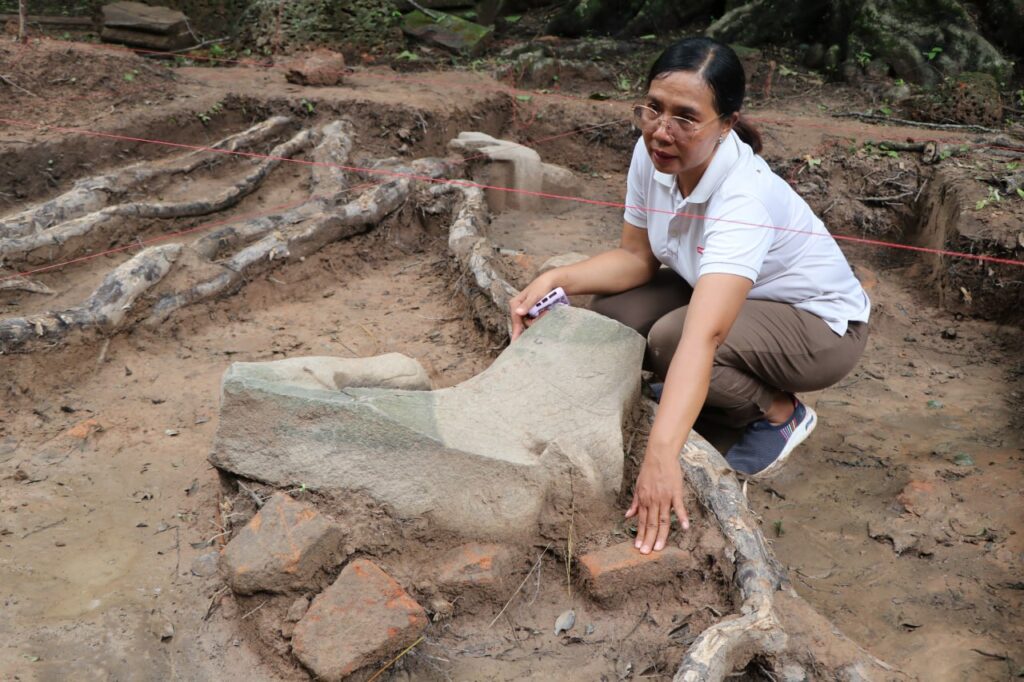ក្រុមអ្នកបុរាណវិទ្យានៃអាជ្ញាធរជាតិអប្សរា សហការជាមួយស្ថាប័នស្រាវជ្រាវបុរាណវិទ្យាឥណ្ឌា(ASI) កំពុងធ្វើកំណាយនៅក្នុងបរិវេណប្រាសាទតាព្រហ្ម រកឃើញបំណែកក្បាលនាគ ដែលជាផ្នែកមួយរបស់បដិមាព្រះពុទ្ធបដិមាប្រក់នាគតម្កល់នៅក្នុងសាលរបាំ រួមទាំងបំបែកផ្សេងៗរបស់បដិមាតូចធំមួយចំនួនផង។
បុរាណវិទូ លោកស្រី នេត ស៊ីមន ឱ្យដឹងថា កាលពីខែកក្កដា ឆ្នាំ២០២៤ ក្នុងពេលដែលក្រុមការងារបានរៀបចំសម្រង់ប្លង់បំណែកថ្មដែលនៅរាយប៉ាយជុំវិញរោងទងទី៣នៃប្រាសាទតាព្រហ្មបានប្រទះឃើញបំណែកខ្លួននាគមួយផ្នែកនៃចម្លាក់បដិមាព្រះពុទ្ធប្រក់នាគ មួយផ្នែកកប់នៅក្នុងដី។ ក្រោយពីកំណាយឃើញថា ថ្មនៃបំណែកក្បាលនាគនេះ គឺជាបំណែកចម្លាក់នាគ ដែលជាដងខ្លួននាគរបស់ព្រះពុទ្ធប្រក់នាគ ដែលបានយកទៅដាក់តម្កល់ក្នុងសាលរបាំ។
ប៉ុន្តែ បំណែកក្បាលនាគមានត្រឹមក្បាលតែ២ប៉ុណ្ណោះ គឺក្បាលផ្នែកកណ្តាល និងខាងស្តាំ ក្នុងចំណោមនាគក្បាល៧។ អ្វីដែលធ្វើឱ្យអ្នកជំនាញសន្និដ្ឋានថា ជាបំណែកមួយរបស់ព្រះពុទ្ធប្រក់នាគ គឺមុខថ្មមានទំហំត្រូវគ្នា សាច់ថ្មតែមួយ រួមទាំងក្បូរក្បាច់ក្នុងទម្រង់ដូចគ្នា។ តាមស្ថានភាពនៃបំណែកក្បាលនាគកប់នៅក្នុងដីនេះ គឺមានការរៀបចំទុកយ៉ាងត្រឹមត្រូវ ដែលអ្នកជំនាញគិតថា បំណែករូបនេះ ត្រូវបានគេកប់ទុកនៅទីតាំងនេះ ដោយការគោរព ដែលប្រហែលជានៅក្រោយរាជព្រះបាទជ័យវរ្ម័នទី៧ ពេលដែលផ្លាស់ប្ដូរសាសនាពីពុទ្ធសាសនាមហាយានទៅព្រហ្មសាសនាវិញ។ ក្រុមការងារសង្ឃឹមថា នឹងអាចរកឃើញផ្នែកផ្សេងៗរបស់ពុទ្ធបដិមាប្រក់នាគដ៏ធំមួយនេះបន្ថែមទៀតនាពេលអនាគ ដើម្បីយកមកផ្គុំឡើងវិញ ឱ្យបដិមានេះពេញរូបរាង ទុកឱ្យពុទ្ធសាសនិកគោរពបូជាតាមជំនឿ។
បុរាណវិទូ ឱ្យដឹងទៀតថា ក្រៅពីបំណែកក្បាលនាគដ៏សំខាន់នេះ ក៏រកឃើញបំណែកផ្សេងៗរបស់ពុទ្ធបដិមា និងចម្លាក់ផ្សេងៗមួយចំនួនទៀត មានដូចជា ប្រអប់ដៃ ប្រអប់ជើង ដងខ្លួន ជើងទម្រ ព្រះសិរ ជាដើម៕
អត្ថបទ៖ ឆាយ ផាន់នី
រូបភាព៖ ភោគ ជា/លោកស្រី នេត ស៊ីមន
Archaeologists from the APSARA National Authority, in collaboration with the Archaeological Survey of India (ASI), have made a significant discovery at the Ta Prohm Temple. During ongoing excavation research, they uncovered head fragments of a Naga Buddha statue, along with other statue fragments, in the temple’s Dance Hall.
According to archaeologist Neth Simon, the team found the head fragments in July 2024 while cataloging stone fragments scattered around the third gallery of Ta Prohm. The fragments were partially buried in the ground. Upon excavation, it was revealed that the stone pieces belonged to the Naga Buddha statue, specifically the middle and right heads of a seven-headed Naga.
Experts believe that one of the head fragments matches the size and design of the existing pieces, indicating they once formed part of a larger statue. The careful arrangement of these fragments suggests they were buried with reverence, likely after the reign of King Jayavarman VII, during a period of transition from Mahayana Buddhism to Brahmanism.
The archaeological team is optimistic about finding additional parts of this significant statue in future excavations, aiming to reassemble it for worship by Buddhists. In addition to the Naga Buddha fragments, other notable finds include parts of Buddha sculptures, arms, legs, and pillars.
Article: Chhay Phanny
Photos: Phouk Chea / Neth Simon
Article Translation: Net Phirun
Share:
Our Latest News

អាជ្ញាធរជាតិអប្សរា រៀបចំកម្មវិធីបណ្ដុះគំនិតកុមារចេះថែរក្សាបរិស្ថានក្នុងតំបន់អង្គរ- APSARA National Authority organizes an environmental training program for children in the Angkor site- 29 May 2025
ថ្ងៃទី២៩ ខែឧសភា ឆ្នាំ២០២៥ អង្គភាពប្រព័ន្ធគ្រប់គ្រងបរិស្ថានអង្គរនៃអាជ្ញាធរជាតិអប្សរា សហការជាមួយសាលាបឋមសិក្សាចំនួន៣ មានសាលាបឋមសិក្សាដូនឪ សាលាបឋមសិក្សាត្រពាំងស្វាយ សាលាបឋមសិក្សាគោកគ្រើល ស្ថិតក្នុងស្រុកអង្គរធំ ខេត្តសៀមរាប




